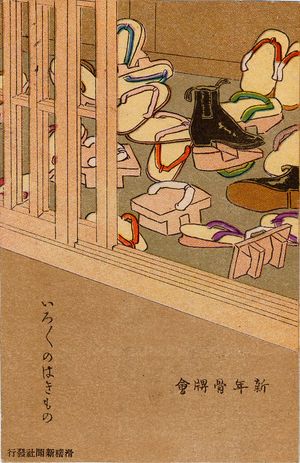Last updated: .
Karuta (かるた) is the general name for Japanese playing cards, derived from the Portuguese word for playing cards, carta.

新年骨牌会, a New Year playing-card gathering
Unknown author (1908)
After being introduced by Portuguese sailors and merchants in the late 16th century,A playing cards in Japan underwent a long period of “speciation” due to the isolationist sakoku (鎖国, ‘closed country’) policy of the Tokugawa shōgunate which severely limited contact with the outside world for over 200 years.
Cut off from their original source, these playing cards were developed in new and surprising ways. Decks were increased in complexity by adding more ranks or additional suits. Later on, new variants were introduced to circumvent anti-gambling laws, to obscure the true nature of the cards as gambling implements, or to simplify existing decks by removing suits or ranks.
There are two main family “branches” of cards, and a third that derived from both of these:
- Cards derived from Portuguese patterns, with suits and ranks. In order of
appearance these are:
- Tenshō Karuta (
天正カルタ, ‘Tenshō cards’), closely followed by:
- Unsun Karuta (うんすんかるた , ‘Un-Sun cards’)
- Sunkun Karuta (すんくんかるた , ‘Sun-Kun cards’)
- Mekuri Karuta (捲りかるた
, ‘turning cards’) were an alteration of the Tenshō pattern cards, possibly created to evade bans on
those cards. The structure of the deck remains the same, but there are
many different regional artwork patterns.
- Shimafuda (島札) are a still-surviving descendent of mekuri cards, originating from Okinawa.
- Kabu
Karuta (株かる
た) were a further simplification of mekuri cards, eliminating all suits except for one,
which is replicated four times. Like mekuri
cards, there are many regional varieties.
- Kabufuda (株札) is the only type still in mass production.
- Tenshō Karuta (
天正カルタ, ‘Tenshō cards’), closely followed by:
- Cards used for simpler matching games, not organized into suits or ranks:
- Uta-garuta (歌かるた,
‘poetry cards’), of which there are many sub-types, including:
- Hyakunin Isshu (百人一首)
- Genji Karuta (源氏かるた)
- Iroha-garuta (いろはかるた, ‘alphabet cards’)
- Uta-garuta (歌かるた,
‘poetry cards’), of which there are many sub-types, including:
- Hanafuda (花札, ‘flower cards’) are derived from a combination of both the Portuguese and the matching-type cards.
#References
Mann, Sylvia and Virginia Wayland (). The Dragons of Portugal. Sandford: Surrey, England, UK.